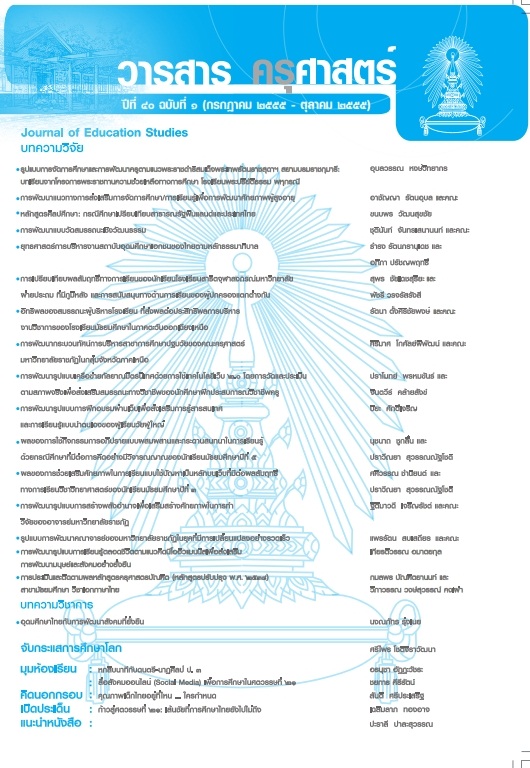การพัฒนารูปแบบเครือข่ายกัลยาณมิตรนิเทศด้วยการใช้เทคโนโลยี เว็บ ๒.๐ โดยการวัดและประเมินตามสภาพจริงเพื่อส่งเสริม สมรรถนะทางวิชาชีพของนักศึกษาฝึกประสบการณ์วิชาชีพครู
Abstract
การวิจัยครั้งนี้มีวัตถุประสงค์เพื่อ ๑) ศึกษารูปแบบเครือข่ายกัลยาณมิตรนิเทศด้วยการใช้เทคโนโลยีเว็บ ๒.๐ โดยการวัดและประเมินตามสภาพจริงเพื่อส่งเสริมสมรรถนะทางวิชาชีพของนักศึกษาฝึกประสบการณ์วิชาชีพครู โดยการวิเคราะห์ สังเคราะห์เอกสารและงานวิจัยที่เกี่ยวข้อง และศึกษาความคิดเห็นของผู้เชี่ยวชาญจำนวน ๑๗ ท่าน โดยใช้เทคนิคเดลฟาย ๒) สร้างรูปแบบเครือข่ายกัลยาณมิตรนิเทศฯ ๓) ศึกษาผลของการใช้รูปแบบเครือข่ายกัลยาณมิตรนิเทศฯ ที่พัฒนา ๔) นำเสนอรูปแบบเครือข่ายกัลยาณมิตรนิเทศฯ กลุ่มตัวอย่างในการวิจัย คือ นักศึกษาครูที่ฝึกประสบการณ์วิชาชีพครูของคณะครุศาสตร์ มหาวิทยาลัยราชภัฏลำปาง แบ่งเป็นกลุ่มทดลอง ๑๕ คน และกลุ่มควบคุม ๑๕ คนเครื่องมือที่ใช้ในการวิจัย ได้แก่ แบบสอบถาม แบบสัมภาษณ์ แบบประเมินสมรรถนะทางวิชาชีพครูวิเคราะห์ข้อมูล โดยหาความถี่ ค่าร้อยละ ค่าเฉลี่ยเลขคณิตและส่วนเบี่ยงเบนมาตรฐาน และ t-test
ผลการวิจัย พบว่า ๑) รูปแบบประกอบด้วย ๓ องค์ประกอบ ได้แก่ สมาชิกเครือข่ายกัลยาณมิตรนิเทศ การวัดและประเมินตามสภาพจริง และ เครื่องมือของเทคโนโลยีเว็บ ๒.๐ ๒) รูปแบบประกอบด้วย๖ ขั้นตอน ได้แก่ ขั้นผูกโยงเครือข่าย ๒) ขั้นสร้างความสัมพันธ์ มุ่งมั่นสู่จุดมุ่งหมาย ๓) ขั้นรับกัลยาณมิตรหมั่นฝึกจิตความเป็นครู ขั้นร่วมช่วยแก้ไข เปิดใจรับเพื่อปรับปรุง ขั้นประเมินผล พิสูจน์ตนเชิงประจักษ์และ ขั้นขยายเครือข่าย ผลของการใช้รูปแบบเครือข่ายกัลยาณมิตรนิเทศฯ พบว่า กลุ่มทดลองมีคะแนนประเมินเฉลี่ยของพฤติกรรมการจัดการเรียนรู้ ทักษะการวิจัยเพื่อพัฒนาการเรียนรู้ และคุณลักษณะความเป็นครู สูงกว่ากลุ่มควบคุมอย่างมีนัยสำคัญทางสถิติที่ระดับ .๐๕
This research aimed to: 1) study models of amicable supervision networks usingWeb 2.0 technologies based on authentic assessment to enhance professional teachingcompetencies for pre-service teachers through the analysis and synthesis of relateddocuments, and study the opinions of 17 experts using the Delphi technique; 2) develop amodel of an amicable supervision network; 3) study the results of the use of the developedmodel; and 4) propose the model of an amicable supervision network. The samples of thestudy were pre-service teachers of the Faculty of Education, Rajabhat Lampang University.F ifteen pre-service teachers were assigned to an experimental group and another 15pre-service teachers to a control group. The research instruments used in this study werequestionnaires, an interview form, and a teacher competency assessment form. Data wereanalyzed using frequency, percentage, mean, standard deviation, and t-test.
The results revealed that: 1) The model consists of 3 dimensions: members of theamicable supervision network; authentic assessment; and tools of Web 2.0 technologies.2) The model consists of 6 steps: network building; relationship building and commitmenttowards the goal; accepting amicableness and persistent training as a teacher, solvingproblems together and being open-minded to improvement, assessment and empiricalself improvement, and network expansion. 3) The mean scores of the learning managementbehaviors, the research skills for learning development, and the teacher characteristics ofthe experimental group were signif icantly higher than the mean scores of the controlgroup at a .05 level.




